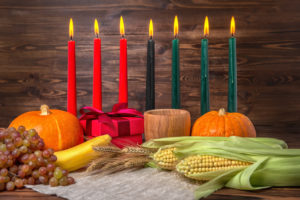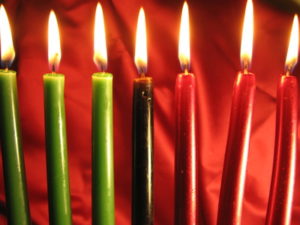How to Create Incredible Kwanzaa Decorations

Kwanzaa decorations aren’t easy to find. Despite the fact that it’s been celebrated since 1966, few companies make or sell them. Those that do have been selling the same patterns for over 25 years.
In fact, many people only know the holiday in passing.
What is Kwanzaa?
The name comes from a Swahili phrase: “matunda ya kwanza,” which means “first fruits.”
Kwanzaa is a cultural holiday. Though it’s celebrated from December 26 to January 1st, it is a harvest festival. It is not a replacement for Christmas.
Some people assume the holiday draws from many different religious traditions, but this isn’t quite the case. The holiday is cultural, not religious. Much of this confusion arises from the presence of the Kwanzaa candelabra known as the kinura in the traditional celebration. The kinura resembles a menorah, but they are not the same.
Kwanzaa is meant to be available and accessible to black people of any religious faith. It is a celebration of the rich history and culture found in so many forms throughout black societies around the world.
Who Celebrates Kwanzaa?
18 million people of African descent celebrate Kwanzaa worldwide. But people of all racial backgrounds are often welcomed to the celebration.
Those who do not share any recent African heritage (all human life made its first appearance in Africa) should approach any celebrations with respect, just as a Christian might when invited to attend a Hanukkah celebration.
In America, only about 35% of the black population currently celebrates the holiday. Many of our readers will celebrate the holiday for the first time this year!
How to Decorate for Kwanzaa
Every good celebration starts with great decorations.
The Seven Days of Kwanzaa
Each day of Kwanzaa has its own symbolic meaning.
● December 26th – Umoja – Unity
● December 27th – Kujichagulia – Self-Determination
● December 28th – Ujima – Collective Work & Responsibility
● December 29th – Ujamaa – Cooperative Economics
● December 30th – Nia – Purpose
● December 31st – Kuumba – Creativity
● December 1st – Imani – Faith
The meanings of these 7 Kwanzaa principles each weave in and out of traditional decorations.
Kwanzaa Decorations
Mekeka
First, you need mekeka. These are woven placemats symbolizing the family. These are typically green, red, yellow, and black. Though they would traditionally be woven out of straw, creating them out of construction paper is among the popular Kwanzaa activities for kids.
Kinura
 Next, you’ll need the kinura, which is the candle holder itself. This represents the parents. If you’re handy you can find nearly everything you need to make your own down at the hardware store.
Next, you’ll need the kinura, which is the candle holder itself. This represents the parents. If you’re handy you can find nearly everything you need to make your own down at the hardware store.
Candles
The Kwanzaa candles are the next traditional decoration. You’ll need three red ones to signify struggle, three green ones to signify the future, and one black one to signify the African people.
Unity Cup
The “unity cup” is next. These can be made of wood, but you can also make yours with a colorful plastic party glass wound round with festive beads, affixed to the goblet with hot glue. You’re not bound by the three traditional Kwanzaa colors here: the cup is used to pour libations in memory of deceased loved ones or ancestors. Thus, you could use any colors that remind you of these individuals. The glass itself should be in one of the three traditional colors if it is not made out of wood.
Vibunzi
Next up is the vibunzi. This is an ear of corn meant to signify each child. Using colorful decorative corn is one option. Another is to make festive corn husk vases for each child. Use hot glue to affix a corn husk to a short glass, a little wood stain to give the husks a nice color, and colorful braided yarn to add visual interest. You can wrap strands of yarn at the top and bottom, or around the middle. Affix the yarn with your glue gun, then add festive flowers.
Mazao
The mazao is next: a bowl of your freshest fruits and vegetables to symbolize the harvest.
Zawadi
Finally, the zawadi: gifts for each child. This is another Kwanzaa tradition which causes some people a lot of confusion, as it might look a lot like a Christmas or Hanukkah tradition. But Kwanzaa gifts aren’t meant to be games or toys. They usually consist of a book and a symbol of cultural heritage.
“Choose the Best and Most Beautiful”
The Official Kwanzaa Website offers guidance on how to celebrate Kwanzaa. One of the principles is that celebrants should not mix the symbols or decorations with those that come from any other culture. They may draw from other religions, but should be African in execution.
The other is that celebrants should choose the best and most beautiful decorations they can find or create.
Other Ideas for Your Kwanzaa Celebration
Many celebrants choose to give each other Kwanzaa cards. As with the decorations, there are very few pre-printed or pre-made options.
Thus, it’s a great time of year to get creative! You can create your own cards. Use heavy card stock, markers, or other creative touches to send well wishes that are entirely your own.
You can also make some of your zawadi. For example, the cultural heritage symbol could be a handmade string of colorful beads, or a small African drum.
Here at Paper Plus, we do have plenty of materials that can help you make all the decorations, cards, and gifts mentioned in this article. Stop by at 1629 San Pablo in Berkeley, CA and ask what we’ve got in stock right now!
We can help you make your Kwanzaa celebration truly special this year.


